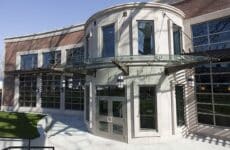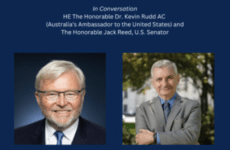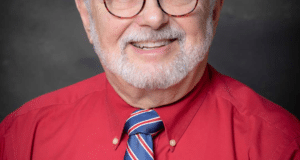By Lauren Kane,
International News Editor
The latest installment in the Atwood Lecture Series was an examination of modern architecture in an entirely new light. Dr. Dietrich Neumann, an architectural historian and assistant professor at Brown University, presented “The Structure of Light: Modern Architecture and its Illumination” February 13 in Bazarsky Lecture Hall. The thesis of the lecture was an analysis of the interaction of light and space in the 21st century.
“Light and architecture must surely reflect what it means to be human,” said Dr. Curtis as she introduced Dr. Neumann and his discourse, in reference to how these two elements can define the spaces we inhabit.
Dr. Neumann began his lecture with a history of how the use of artificial light came to play a role in architecture. The availability of electric light in the early 20th century brought about the phenomenon of lighting the facades of city buildings. Dr. Neumann pinpointed Chicago as the site of the first example of this, when the Wrigley Building in 1920, and later the Chicago Tribune Tower, competed to outshine each other.
Dr. Neumann established that modern architecture emerged from the influence of illumination. As the shadows cast on historical- and classical-style buildings by upward lighting create an eerie effect, the need for the straight and minimalist designs of modernism arose. Examples discussed at length in terms of modern architecture were the Blanchette Rockefeller’s groundbreaking New York apartment built in 1948, and Philip Johnson’s renowned glass house in New Canaan, Connecticut.
For visual aid during his slide show and lecture, Dr. Neumann used high definition panoramic photos that he had taken while in the field. The slideshow also featured the professor’s photos of diary entries belonging to the architectural lighting pioneer and master Richard Kelly. Dr. Neumann came into possession of the diary entry for each day of Kelly’s life through the friendship of a relative of the illumination innovator.
The lecture was followed by a brief session for question and answer, during which students inquired on the professor’s feelings light pollution and the future of architectural illumination.
“LED can be so focused that there is no light spillage,” said Dr. Neumann. This relatively new form of lighting is beneficial in that the concentration of light beams don’t overflow into spaces they aren’t meant to be, hopefully helping to solve the growing problem of light pollution.
The lecture was free of charge, and open to the Newport and Salve Regina communities. Those eligible were invited to attend the wine and cheese reception following the lecture.














